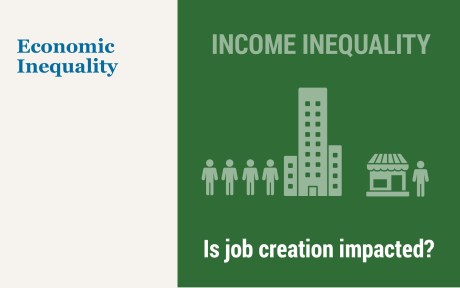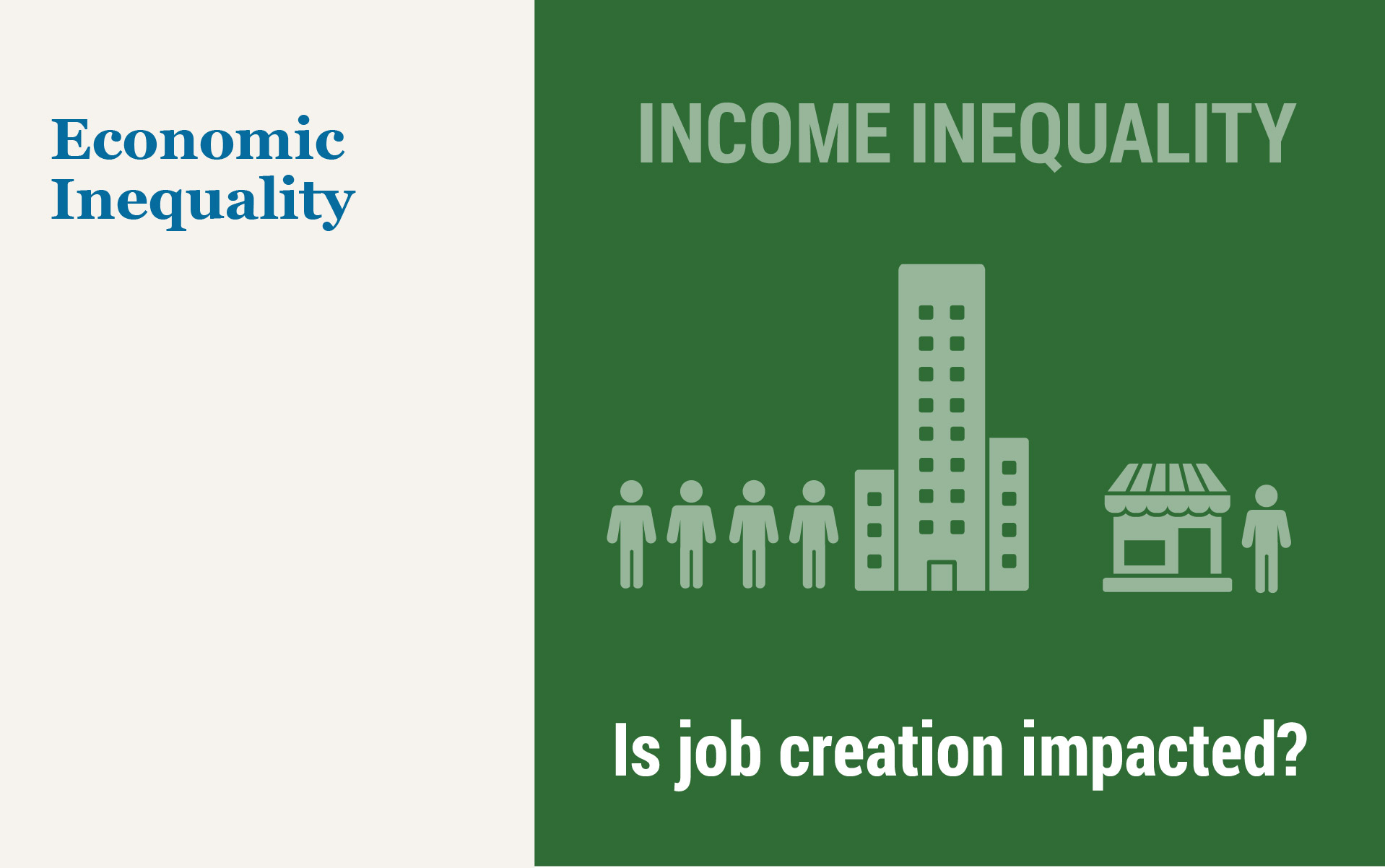
The share of income going to high-income households has increased significantly in the United States in recent decades. In 1980, the average income share of earners in the top 10 percent was around 30 percent. However, by 2015, it had surpassed 45 percent. The employment share of small firms has also declined, with a decrease of approximately 5 percentage points over the same period. In this post, we use variation across states to show a correlation between these two developments, with states having the greatest increase in the upper income share also tending to be those with the biggest job creation declines in small firms compared to large firms. One explanation for this correlation is that the increase in the income share of the highest income earners reduced deposits in small and medium-size banks from what they otherwise would have been. In doing so, this shift in income reduced the available credit for small firms, putting them at a disadvantage relative to large firms.
Household Portfolios and Firms’ Funding Sources
The chart below shows the two trends, with income share for earners in the top 10 percent trending up and the share of employment by small firms trending down. Are these developments related?
Top Income Shares Have Increased While Small Firm Employment Has Fallen
Note: The chart shows the evolution of the top 10 percent income share, averaged across states, over time (blue line) and the evolution of employment share of small firms with 1-499 employees (red line) over time.
As in our recent Staff Report, we first note that small firms do not have ready access to capital markets, making them heavily reliant on bank loans. We also know that banks primarily depend on deposits to provide loans (as shown in the right panel of the chart below) and that the share of bank deposits in a household’s balance sheet is inversely related to income (as shown in the left panel). Specifically, Survey of Consumer Finances (SCF) data show that deposits account for more than 60 percent of financial portfolios for households in the first quintile of the wealth distribution but less than 20 percent for the top 10 percent wealthiest households in the U.S. We posit that rising income inequality negatively affects small firms, as it reduces bank deposits and weakens banks’ lending capacity. Large firms, with access to capital markets, benefit from increased holdings of bonds and stocks resulting from more income inequality, positively affecting their employment levels.
Bank Deposits Reflect Income Inequality
Deposit Shares across Income Groups
Sources of U.S. Bank Funding
Sources: Federal Reserve Board’s Survey of Consumer Finances (left panel); Federal Deposit Insurance Corporation (right panel).
Notes: The left panel presents the allocation of households’ financial wealth in deposits (the sum of checking accounts, savings accounts, call accounts, and certificates of deposit) and other financial assets (life insurance, savings bonds, money market deposits, money market mutual funds pooled investment funds, stocks, bonds, and other financial assets) by income group. The right panel provides a breakdown of banks’ total liabilities into deposits held in branches located in the banks’ headquarters state, deposits held in branches located outside the banks’ headquarters state, and liabilities other than deposits. Numbers reflect averages across all banks and years in the sample.
Heterogeneous Effects of Rising Income Inequality on Firms
To test this theory, we investigate whether an increase in top income shares within a given state leads to a decrease in net job creation by small firms compared to large firms in that state. For income share data, we utilize state-level pretax adjusted gross income data reported in the Statistics of Income published by the Internal Revenue Service. For employment data, we turn to the Business Dynamics Statistics (BDS) provided by the Center for Economic Studies, which offers detailed information on job creation across firms of different sizes.
Using these datasets, we exploit variations across states to examine the connection between income inequality and the net job creation of firms of different sizes. To identify causal effects, we construct a predicted income share series for each state by adjusting its 1970s income shares with the corresponding “leave-one-out” national income share growth rates during sample periods. Specifically, we exclude each respective state when computing the national income share growth rates for that state. Then we use the predicted income shares as an instrumental variable, given that it is not affected by state-specific shocks that may have occurred since the 1970s but it explains a significant share of the actual evolution of income shares during the sample periods.
The results from our empirical analysis indicate that higher levels of income inequality, as measured by higher top-income shares, lead to a reduction in net job creation within small firms relative to large firms. Specifically, our main estimate suggests that a 10 percentage point increase in the top 10 percent income share results in a decline of 1.6 percentage points in the net job creation rate of small firms compared to large firms. Considering that the state-level top 10 percent income share had, on average, increased about 10 percent from 1980 to 2010, our finding implies that net job creation of small firms would have been 1.6 percentage points higher if the level of income inequality had remained at its 1980s level. This effect is economically significant, given that the average job creation rate at small firms in the 1980s stood at 4.2 percent.
Building a Model
Finally, we build a structural model of the U.S. economy to examine the aggregate implications of rising income inequality. To replicate our empirical findings with the model, we incorporate key ingredients of our proposed mechanisms into the model, with deposit shares in household portfolios decreasing in income, small firms relying exclusively on bank loans while large firms have access to the capital market, and banks collecting deposits to make loans. We then increase the degree of income inequality in the model by implementing lump-sum transfers among households. This enables us to examine the extent to which the observed decline in the employment share of small firms in the data can be attributed to our proposed explanation.
In increasing the top 10 percent income share from 30 percent to 50 percent, we find that the inequality-induced reallocation of resources leads to a 0.9 percentage point decrease in the employment share of small firms. In the U.S., the employment share of firms with fewer than 500 employees decreased by 4.9 percentage points between 1980 and 2015. Therefore, according to our model simulation, the rise in inequality explains approximately 20 percent of the total reduction in the small firm employment share over this period.
Implications
Our paper’s findings indicate that increasing income inequality has had a negative effect on job creation within small firms in comparison to large firms. This sheds light on the potential amplification of shocks that influence household inequality. Especially when lower-income households are predominantly engaged in or employed by small firms, a negative shock that disproportionately affects these households and leads to higher income inequality can exacerbate income disparities further by impacting small firms disproportionately.

Donggyu Lee is a research economist in Macroeconomic and Monetary Studies in the Federal Reserve Bank of New York’s Research and Statistics Group.
Thomas Drechsel is an assistant professor at the University of Maryland.
Sebastian Doerr is an economist at the Bank for International Settlements.
How to cite this post:
Donggyu Lee, Thomas Drechsel, and Sebastian Doerr, “Does Income Inequality Affect Small Firms?,” Federal Reserve Bank of New York Liberty Street Economics, October 5, 2023, https://libertystreeteconomics.newyorkfed.org/2023/10/does-income-inequality-affect-small-firms/.
Disclaimer
The views expressed in this post are those of the author(s) and do not necessarily reflect the position of the Federal Reserve Bank of New York, the Federal Reserve System, or the Bank for International Settlements. Any errors or omissions are the responsibility of the author(s).
Source link









